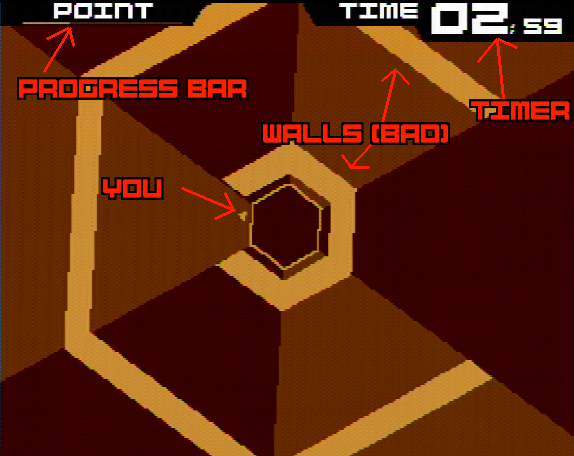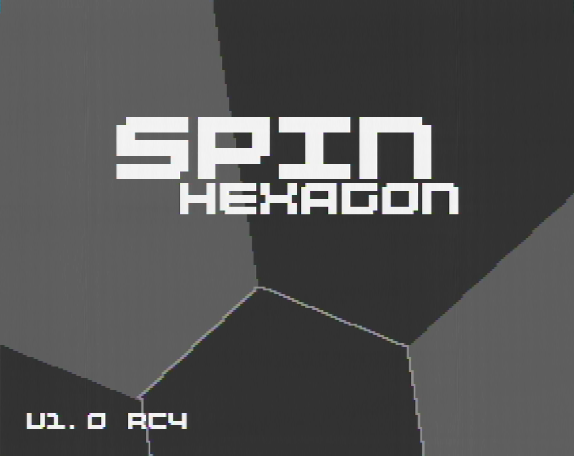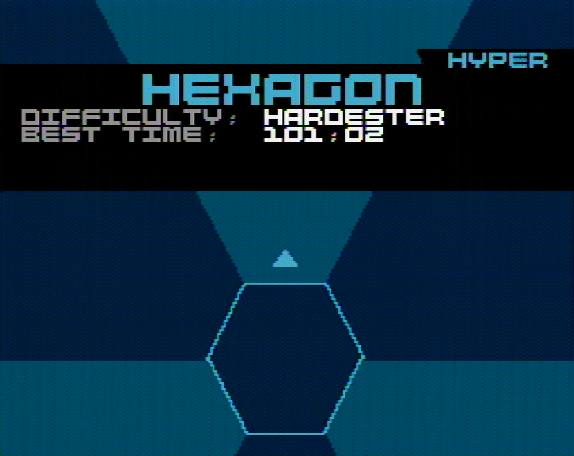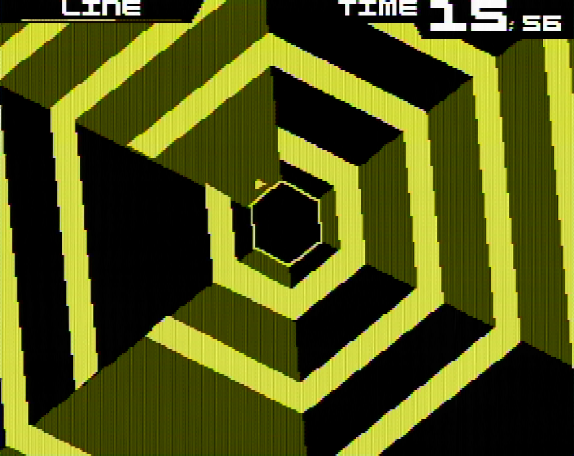Spin Hexagon is a port of Super Hexagon to the Propeller 1. It implements most features from the original game. (Most notably absent are the pentagon/square modes and the ending sequence.)
You control the little triangle orbiting the central Hexagon. The object of the game is to avoid getting hit by the incoming walls for as long as possible. Simple, isn't it?
| Keyboard | SNES | What it does |
|---|---|---|
| Arrow Keys | D-Pad or L/R | Rotate triangle |
| Space Bar | A | Confirm / Restart |
| Esc | Start | Give up / Back |
| PrintScr | Select | Switch NTSC/PAL60 |
| Ctrl+Alt+Del | --- | Quit game (REBOOT) |
- 80 MHz CLKFREQ or more
- Standard TV output circuit (CRT-based TV/monitor recommended)
- Standard audio output circuit (stereo recommended)
- PS/2 keyboard or SNES controller (you can of course easily modify the code to support whatever you need)
- SD card (you can play without, but you won't get any sound and won't be able to save your best times and unlocked levels.)
See the relevant FAQ section for porting instructions.
^^ That last one is actually a video, click it to watch.
I like to use the rake build system, but if you don't want to install that, I've provided instructions for building manually.
You will need:
- flexspin/fastspin 4.3.0 or 5.0.0. (
Current version has regressions preventing it from buildingShould be fine again) - ruby 2.6 (lower/higher should work)
- rake (usually bundled with ruby)
Simply type rake and it will compile everything you need. Head on to the installation question.
If you have modified any file and want to re-build, you might have to run rake clean first (this wouldn't be necessary if fastspin could emit dependency info - get on it, Eric :) )
You will need:
- flexspin/fastspin 4.3.0 or higher. (Note that versions below 5.0.0 are called "fastspin", adjust the commands accordingly if using such a version)
Run the following commands:
flexspin -O1,inline-single,loop-reduce --fcache=86 -c Keyboard.spin
flexspin -O1,inline-single,loop-reduce --fcache=86 -c tinySDDA.spin
flexspin -O1,inline-single,loop-reduce --fcache=86 -c VJET_v00_composite.spin
flexspin -O1,inline-single,loop-reduce --fcache=86 -c VJET_v00_rendering.spin
flexspin -O1,inline-single,loop-reduce --fcache=86 -l hexagon.spin
flexspin -O1,inline-single,loop-reduce --fcache=86 -l hexagon_boot.spin
copy hexagon.binary HEXAGON.BI2
copy hexagon_boot.binary HEXAGON.BIN(use cp instead of copy on Linux/BSD/MacOS)
Copy HEXAGON.BI2 and all .RAW and .VU files (don't worry, it will yell at you if you miss one) into the root directory of your SD card.
Then, if you are using an OS like VentilatorOS that can boot .BIN files, also copy HEXAGON.BIN. Else, load hexagon_boot.binary into EEPROM or RAM the usual way.
Load hexagon.binary into EEPROM or RAM the usual way. You will not get any sound and won't be able to save your best times and unlocked levels.
Simply open up platform.spin and adapt it to your needs.
Note that if you want an input method that is neither a SNES controller nor a PS/2 Keyboard, you will have to modify the code - look into PUB update in hexagon.spin
Also note that C3-style SPI busses are not supported at the moment, but modifying the code for that shouldn't be too difficult - tinySDDA in particular just selects the card once and never deselects it, so you'd only need to tweak the init code. Relatedly, not that the version of SD-MMC_FATEngine.spin used by the booter is slightly customized - it has some slight Spin modifications to allow finding the sector adresses of files and a small ASM modification to leave the last 512 bytes of RAM alone when booting.
Also note that there is currently no VGA support whatsoever. If you want to port to VGA (or P2!) please contact me, I can give you some materials and advice.
I've got permission from the creator of Super Hexagon to distribute Spin Hexagon.
Hey!
Yes, you have my permission to distribute this however you like! This looks fantastic, by the way - I can really see an attention to detail in recreating the wave design and timing from Super Hexagon. Nice work!
-Terry Cavanagh, in an E-Mail to me
Just ask! Ideally in the SpinHexagon thread on the Parallax Forum.
Thanks go out to:
- Terry Cavanagh and Chipzel for Super Hexagon
- Eric Smith @totalspectrum for fastspin and quick response to bug reports
- Chip Gracey for the Propeller chip and some of the included driver code
- Everyone who finds some joy in this project
While you're here, care to check out my Cool Propeller Project List?





